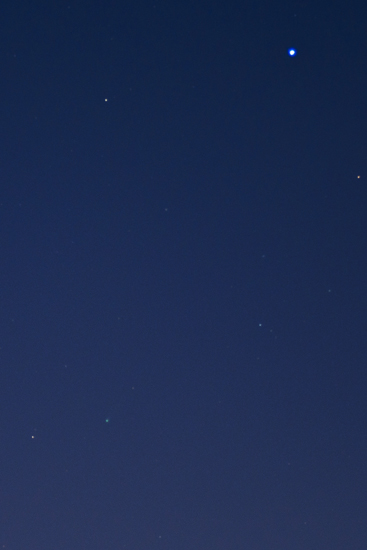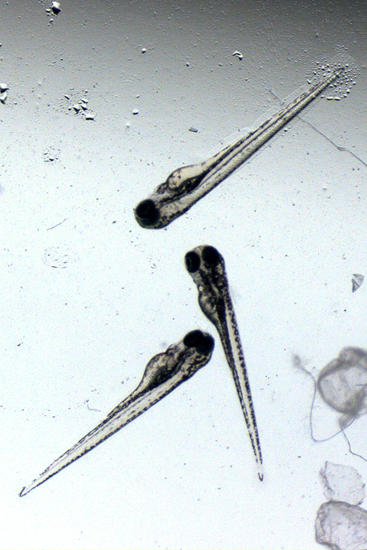Okay, now to the real deal. First off, there is a comet approaching the Sun. It's called ISON, after the worldwide collection of instruments that found it, and right now, it's barely visible to the naked eye an hour before dawn in good dark-sky conditions. (Here's a lot more good info from Bad Astronomy blogger Phil Plait.) I don't live near good dark-sky conditions, but in my little patch of Big Sky, the conditions are passable, and the patch of clear eastern sky is close enough that I don't have to wake up before 5 a.m.
After waking up at 5:30 a.m. on Tuesday morning (granted, it's not much of an improvement from 5 a.m., especially on a school day), I drove out there and parked on the side of Ronald Reagan Parkway. It was really cold, and I didn't have a tripod, so it took a lot of effort to get an eight-second exposure with the roof of my car as the platform and my wallet as a wedge. But I barely got something:

In the upper right corner is the bright star Spica, the brightest in the constellation Virgo. It's a spring constellation, but it's still around in autumn, peaking above the eastern horizon before the sun has a chance to rise. Roughly three-quarters down the photo on the left side is the comet. At least, I hope that green speck with a barely perceptible tail is Comet ISON and that I'm reading the star chart right. Of course, as you can tell from Phil Plait's article, many people have done a much better job, but they had better equipment.
The comet will disappear soon, when it makes its closest approach to the sun on Nov. 28. This close encounter will either kill it, vaporizing it into nothing, or almost kill it, resulting in a small bit of rock and ice with a magnificent tail of vapor. If it's the latter, it'll be quite a sight to see in early December.
That was the "things way up there" part. Now for the things way down here.
As someone who (right now, at least) has plans to apply for a good M.D./Ph.D. program after these IUPUI classes, a background in research is critical. True, I've published five papers about total joint replacement, with more possibly on the way, and I'm very grateful for the opportunity. All of those studies, however, are of clinical research, done explicitly for the purpose of applying results to practice. I need experience in a lab, gathering my own data, designing my own experiments, and doing basic science research that aims to simply learn. There may be concrete results relevant to medicine in these experiments, but the thrill of basic science is that it's a drive to simply know how things work. The research is done for the sake of knowing, which makes the real-world application of the research, if and when it is found, all the more surprising and exciting.
This week, I started volunteering in the lab of Dr. James Marrs, husband of my wonderful introductory biology professor (seriously, Dr. Kathy Marrs is wonderful). Dr. James Marrs studies zebrafish, an itty bitty fish with prodigious abilities to reproduce, progress quickly through embryonic development, and regenerate fins and other tissues after injury. These make it the perfect animal to study the effects of alcohol on embryos, ways to reverse those effects, and tissue regeneration, all of which could be applied to humans.
There aren't many projects going on right before Thanksgiving break, so this week has consisted not been so much of volunteering yet as it has been of watching people and reading papers. In my visit today, though, a post-doc let me take pictures of 3-day-old zebrafish embryos under the microscope. I've gotten pretty good at taking iPhone photos through a microscope eyepiece, but this lab has a Leica microscope. That's right: Leica Microsystems, the brand behind the first practical 35mm camera, makes microscopes that take pictures. I had to try it out, and she happily indulged me with a few embryos from her latest experiment:

These three zebrafish each have progressed a lot in their eye development. You can't tell in this still image, but as I was looking through the eyepiece, I could see rudimentary blood flowing through rudimentary hearts, and some were starting to flap their primitive fins.
These are the experiment's control zebrafish, embryos that have been allowed to grow in a normal environment. One other group in the experiment was exposed to ethanol (the main ingredient in drinking alcohol), and they had smaller eyes and significant edema around their hearts. Another group was also exposed to ethanol, but also to mRNA from a human gene whose analogue is in the zebrafish genome. The purpose of that group was to see if this mRNA, which would be translated into proteins, would counteract the effect of the alcohol and help the zebrafish develop normally. The lab has shown that folic acid can help an alcohol-exposed zebrafish recover normal heart formation, so there's a lot of promise here, especially if it results in effective treatments for fetal alcohol spectrum disorder.
It's pretty awesome to take pictures of people. It means you get to talk to them, learn their stories, and empathize. But taking pictures of these extremes of existence, a comet hurtling toward the sun and baby zebrafish with huge eyes and hearts you can see through their skin? That's pretty damn cool, too, even if there are no people at these scales. The fact that, with zebrafish, I might be able to contribute to important research at this level of existence thrills me. In fact, I am beyond thrilled. I'll try to think of a good word for it, but that's the best I can explain this feeling.
